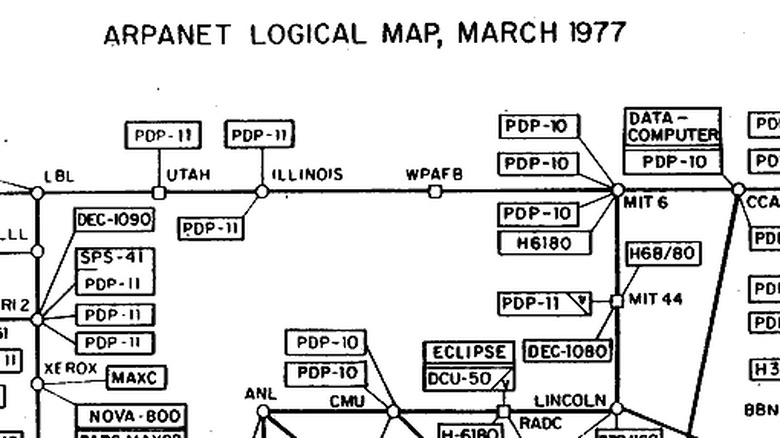How Marijuana Is Forever Connected With The History Of The Internet
These days, buying and selling things via the internet is so commonplace and mundane that it's rarely given a second thought. The total value of e-commerce — that is, the total value of all of the goods and services bought and sold online — is just a hair under five trillion dollars as of 2021 and is expected to exceed seven trillion by 2025, according to Statista. Not a bad accomplishment for a technology that, in some corners, was expected to be a flash in the pan.
We've now been buying and selling things electronically for 50 or so years (there's some ambiguity about what counts as an online transaction as regards the early efforts). And in those five decades, not every transaction has been legal. There are systems in place to keep contraband, such as drugs or pirated media, from being bought and sold online, but in the early days, such systems were crude to nonexistent. Nevertheless, it appears, based on some points of view anyway, that the first transaction on the internet was an illegal one. Specifically, a scientist sold another scientist a bag of weed.
A Dimebag Sold On ARPANET
The internet as we know it is available to just about everyone in the developed world, and large sections of the population of less-developed parts of the world. However, when the system that would evolve into today's internet was first put together, people with access to it were few and far between. As Britannica explains, ARPANET, or Advanced Research Projects Agency Network, was a plan by the Pentagon to link computers at Defense Department-funded research institutions together via phone lines. Two of those institutions were Stanford University and Massachusetts Institute of Technology (MIT).
According to the book, "The Dark Net: Inside the Digital Underworld," by Jamie Bartlett, excerpted at Gizmodo, the first internet transaction consisted of a handful of students at Stanford selling a "tiny amount" of marijuana to their colleagues at MIT. There's no word on how much they sold, or how dank this particular batch of sticky icky was.
There are several problems with this, however. As Smithsonian Magazine notes, there was no mechanism by which the buyers could have paid for this doob, so it wasn't so much a transaction on the internet as it was a transaction facilitated by the internet. But, it may have just been proof-of-concept anyway since the sellers would have had to illegally mail the bud to the buyers. And, we're guessing there was plenty of decent weed available in Cambridge in those days anyway.
Other e-commerce firsts
If the first transaction on the internet didn't involve any actual money (and possibly not even any product) changing hands, then what was the first sale in which the money itself was exchanged digitally? That, too, is a matter of dispute.
There were other internet proto-transactions after the Stanford-MIT weed deal, including an order for pizza and one for groceries, but again, the money changed hands at the point of sale, and not via the internet.
According to India Times, the first internet transaction involving actual money took place in 1994, when a man sold a Sting CD to another person via his website NetMarket. The buyer used encryption to send his credit card information to the seller. The entire transaction, including taxes and shipping, came to $12.48, according to Smithsonian Magazine.
But not so fast, says The Internet Shopping Network. They claimed they were selling computer equipment online a few weeks before the Sting CD deal.
Meanwhile, the Stanford-MIT weed deal around 50 years ago, but, though several states have legalized pot for medical and/or recreational use, it still remains illegal as a matter of federal law. That means there's no (legal) buying it and selling it online, and although millions of pounds of the stuff are sent through the mail every year, according to Leafly, it's still quite illegal.


